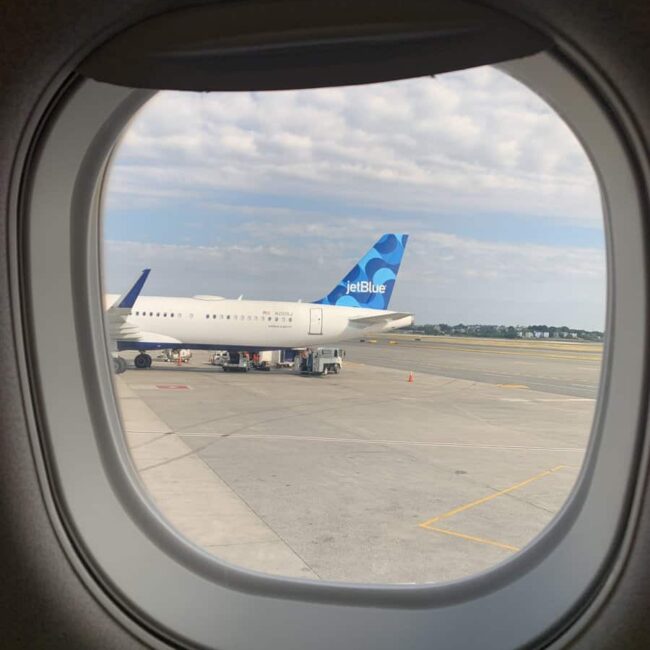

These 5 eco airlines are actively working toward a cleaner future.
Look, we’re not here to tell you to stop flying. At Baggage, we believe that travel has the unique power to connect people to this planet–and to ourselves. In this way, travel fosters the kind of global citizens we so desperately need, to combat climate change. The more of the world you see, the more you’ll want to preserve its natural beauty. If air travel isn’t going anywhere, those who partake in this industry have a responsibility to minimize its negative impact.
As an environmentally conscious traveler, it can be overwhelming to feel the weight of the travel industry’s carbon footprint on your shoulders. But it’s important to remember that it’s not all on you. You are part of a very large system; a single participant in an industry run by major corporations that have the power and the means to make better choices for the planet.
From their supply chains, to their energy usage, consumer preference is finally forcing big companies to take a hard look at their environmental impact. Our best sustainable travel tip is this: recognize the power of the small choices you make every single day. As consumers, our choice is our voice. That’s precisely why we’ve chosen to highlight 5 of the eco airlines that are actively working to combat carbon emissions in innovative ways. The more you know, the easier it becomes to make eco-friendly decisions as a traveler.
You can choose to fly eco airlines that offset carbon emissions for you (Jetblue). Or better yet, pick the airline that eliminates CO2 from the atmosphere altogether (Virgin Atlantic). Be a part of industry research on hydrogen powered aircrafts (Delta Airlines). The possibilities already exist, and innovative technology is fueling a better future for travel. Before we unpack the 5 eco airlines worth flying, let’s break down one of the most common climate solutions these airlines are using to combat carbon emissions: carbon offsetting.
Have you ever been in a relationship where one person seems to just take, take, take? Air travel is the S.O. who takes without remembering the importance of giving — and the planet doesn’t have the power to end this toxic relationship. That part is up to us.
A single passenger flight from London to L.A. emits more carbon than a tree can sequester in 40 years (source: Lonely Planet). The hard truth is that air travel and the planet are just not good together. Does that make eco airlines an oxymoron? Not if airlines choose to offset the carbon emitted during flights.
By now, you’ve probably heard of carbon offsetting. It’s become a bit of a buzzword in the ecotourism industry, and the wider environmental industry. Carbon offsetting is the practice of compensating for the amount of carbon emitted during a particular activity (like flying) by removing that same amount of carbon in some other way. For example, trees are natural carbon absorbers, which is why many companies have turned to planting trees in order to offset their emissions. If a domestic flight releases 31,000 pounds of CO2 into the atmosphere, an airline might plant enough trees to sequester (take in) that same amount, and then declare that they’ve offset the flight. Check out the awesome organization, One Tree Planted, if you want more information on how planting trees offsets carbon.
Below, we share the companies that are putting in the work to offset carbon for you when you fly. But it’s worth knowing that you can also choose to offset your flights yourself. Flygreen is a flight search engine that helps you find clean flights and compensate for your carbon footprint simply by booking through their website. Carbonfund.org also provides a simple calculator: just put in the miles you flew and it will tell you the exact dollar amount to donate in order to offset your flight.
But offsetting isn’t the only solution, and it’s certainly not the best method to protect our planet from emissions in the first place. Airlines are finding new ways to make an impact, and the five listed below have gone above and beyond the basic offsetting model to envision new ways to reduce emissions altogether.
It’s worth considering that our greatest impact may not always be in how much money we spend offsetting our flights. Sometimes we can make a bigger difference with the choice we make about which airline to fly in the first place.
Virgin Atlantic has a unique partnership with a carbon removal company, Storegga, to progress the development of Direct Air Capture. DAC can permanently eliminate CO2 from the atmosphere, making it a better alternative to offsetting.
VA is also the first airline to fly a plane on waste based fuel, by partnering with a company, known as Lanzatech, that converts waste based emissions into ethanol, and then into jet fuel. While Virgin Atlantic is far from having all flights operating on this form of fuel, it’s a positive step in an innovative direction – one that you can reward by choosing to fly with Virgin Atlantic.
Finally, our favorite fun fact: Virgin Atlantic chooses not to offer beef on board (or in clubhouse lounges) and partners with the Sustainable Restaurant Association to offer environmentally friendly meals to passengers. If you’re vegetarian or vegan, Virgin Atlantic is the airline for you.
Source: read more about Virgin Atlantic’s sustainability practices here.
On a JetBlue flight just last week, we learned that JetBlue is now offsetting carbon emissions on ALL domestic flights for its passengers, for free. We applaud this corporation’s acknowledgement of responsibility in this matter. Rather than shifting the blame to consumers–by encouraging us to offset our flights ourselves–as so many other airlines do, JetBlue demonstrates its commitment to passengers and the planet with this initiative. JetBlue is the first U.S. airline to achieve carbon neutrality for all domestic flights.
JetBlue states that it views carbon offsetting as a bridge to other solutions, like fuel with lower emissions. The company is investing in sustainable aviation fuel (SAF).
How is the carbon offset? JetBlue offsets by partnering with offsetting experts Carbonfund.org, EcoAct, and South Pole. This airline plans to reach net zero 10 years ahead of most of its competitors, by 2040.
Source: read more about JetBlue’s sustainability practices here.

EasyJet helps you get just about anywhere you need to go in Europe. We’re big fans of this affordable airline, which is the only airline in Europe (that we know of) to offer free carbon offsetting for passengers.
According to their website, Easyjet is also working on bigger and better ideas to protect the planet. Currently, the airline partners with Airbus and Wright Electric to focus on zero emission technologies of the future and reports: “we are optimistic that we could begin flying our customers on planes powered by hydrogen-combustion, hydrogen-electric or a hybrid of both by the mid to late-2030s.”
Source: read more about EasyJet’s sustainability practices here.
Delta is another airline looking toward the future, and investing in hydrogen powered aircraft research. We admire Delta for its behind the scenes operations that prioritize sustainability in all the little ways that add up to make a big difference.
Recently, the airline has partnered with Someone Somewhere to make products for eligible passengers. Someone Somewhere is an organization worth highlighting, as it uplifts 180 artisans in Mexico’s poorest states, 98% of whom are women. Delta has also begun using 100% recycled polyester bedding and reusable packaging. The company shared that this switch will reduce single-use plastic “by up to 260,000 pounds per year.”
Source: read more about Delta’s sustainability practices here.
Picture a swimming pool. Now picture a second pool. Alaska Airlines has reduced its fuel usage by 34,000 gallons per plane each year. 34,000 gallons is equal to about 2 pools worth of fuel. That’s a big impact. The airline accomplished this by redesigning its aircrafts with different winglets that help reduce fuel usage – proving that investing in innovation can pay off for the planet.
Source: read more about Alaska Airlines sustainability practices here.
Hopefully we’ve saved you a few hours of research on which airlines are worth your time and hard earned money. At Baggage, we travel to fall more in love with the world. And when you love something, you take care of it. If you choose to travel, you must also choose to minimize the negative impact of your trip on the environment. But this doesn’t have to be a hard, or costly, choice. There are travel companies out there working toward a better world, and sometimes it’s as simple as picking an airline you that you know flys with the planet in mind. For our part, we can hold corporations responsible by choosing to support only those that have demonstrated a true commitment to the environment.
At the very least, we should be offsetting our carbon emissions for every flight we take. In reality, we can do even more by offsetting and flying with airlines that are investing in better solutions for the future. Before we take off, let’s take care to consider the planet we love, in our travel plans.
If you’re as obsessed with sustainable travel tips as we are, read more here.

Now more than ever, it’s possible to shop consciously without

If you want to visit the Galápagos Islands in 2025,

What is the most important thing to consider when deciding